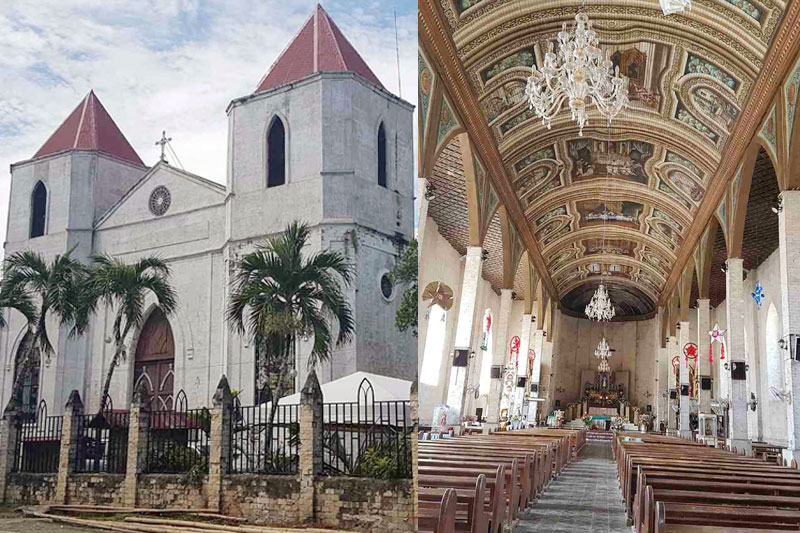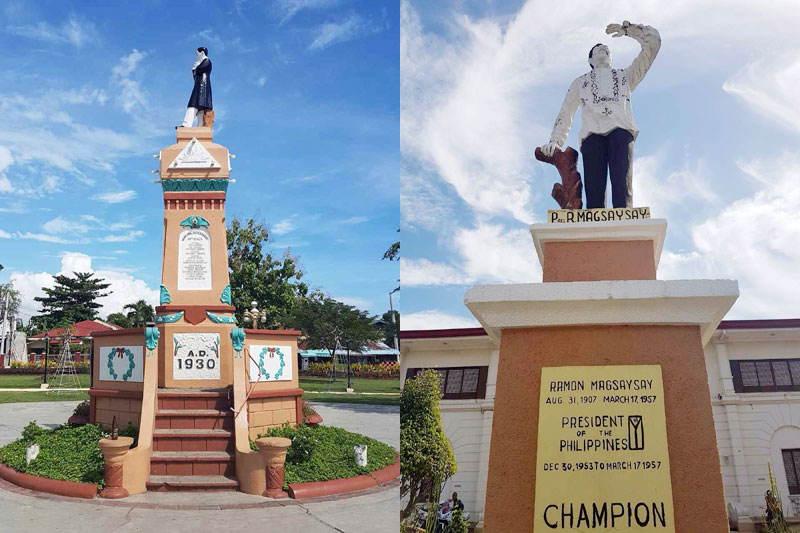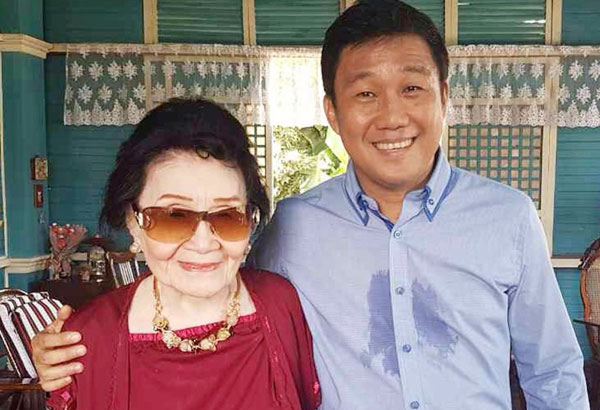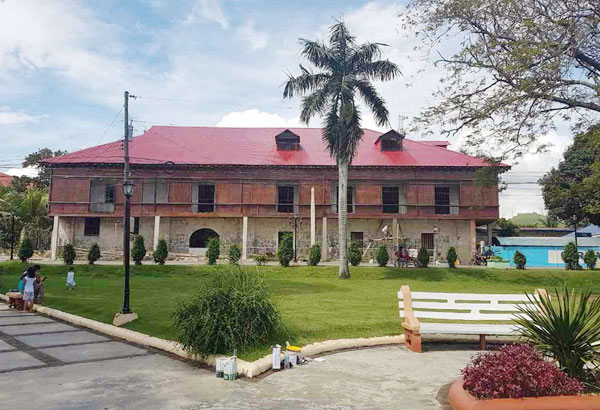Captivating Sibonga

The Sibonga Church and its beautiful interior.
MANILA, Philippines — Carcar, 40 kilometers from Cebu City, is known for its heritage colonial-era houses and its trademark chicharon (fried pork rind). Argao, 68 kilometers further from the island’s capital, is home to popular beaches and has evolved into an adventure escape.
Caught in the middle, eclipsed by these two stars, is the municipality of Sibonga. But like the homely sister of these two well-known settings, it has its own charms as a hideaway destination.
Some 50 kilometers from the provincial capitol’s Kilometer Zero, the slow-paced town with a population of approximately 50,000 offers a moment’s reprieve from the hubbub of its neighbors.
Sibonga is best appreciated on a walkabout, as the sites are conveniently located in close proximity.
We met up with Dr. Noel Ponce, a geriatric practitioner and family friend, the president of the Sibonga Heritage Society and the Ecclesiastical Heritage Commission, an advocate of arts and culture, history and heritage of the poblacion.
The main attraction is the central Sibonga Church.

Statues of Jose Rizal (left) and Ramon Magsaysay, who perished in a plane crash at a nearby mountain
A National Historical Commission marker traced its origin – initially constructed in 1830 through the efforts of four Agustinos Calzados, it was moved to its present location in 1866.
Delayed by natural calamities, the skirmishes of revolutions and continuous lack of funds, it was eventually restored and finished in 1907.
Contrary to the façade with prismatic stained glass windows as its only decor, the interiors hold a different story altogether.
The house of prayer is flanked by rows of pillars, with gothic patterns on its reliefs, while the ceiling boasts of several glass and porcelain chandeliers.
What caught our eye were frescoes – selected Biblical scenes and the seven sacraments – by Cebuano artist Raymundo Francia.
The main altar has a deep nave, and it was likewise painted to present a sunken optical illusion.

Elisa Ortiz and Noel Ponce
Most parishes celebrate one fiesta in honor of their patron saint, but Sibonga holds two celebrations annually.
Spain’s patroness, the Nuestra Señora Del Pilar de Zaragoza, depicted by the Blessed Virgin Mary carrying the Child Jesus atop a pillar surrounded by cherubs, was adopted upon the church’s groundbreaking.
However, during the final construction of the much-delayed church, Santa Philomena had attracted several devotees. The young patron saint of babies, infants and the youth is depicted as holding a whip, anchor and arrows.
Right beside the church is a huge convent, which unfortunately was under renovation. Across the street lies the Heritage Park which hosts a pair of century-old trees with trunks tightly hugged by creepers and vines.
Ivory-covered heritage kiosks are situated next to organized walkabouts bounded by uniform well-trimmed topiaries.
One path led us to the relatively impressive Sports and Cultural Center, the venue for several activities – mainly basketball – a number of beauty pageants and sold-out gatherings spotlighting showbiz personalities.
Across are tennis courts – commonly known as the tenisan – for the occasional game of tennis, but is more utilized for fenced-in dances to fund raise for and support barangay projects.

A convent under construction, right beside the cathedral.
The adjacent public garden showcases a sculpture of national hero Dr. Jose Rizal and our seventh president Ramon Magsaysay, who perished in a plane crash at Cebu’s Mount Manunggal.
Both parks had a slew of benches for weary citizens, and has won admiration and praise for their colorful bougainvilleas and well-manicured greenery – yes, there was not a dry leaf on the ground.
This led us to the recently-painted municipal hall, with a strip of public services and utilities where we were pleased to see the Senior Citizen’s building, the Municipal Health Office complete with a birthing center, all in pristine condition, with old-fashioned capiz windows. Ambulances on standby were likewise quite reassuring to see.
The Sibonga Wharf, a former hub of commerce, where ships with raw products – mostly rice and corn from other municipalities – would regularly dock for milling in the locality’s ever-so-busy seven mills, and then sail away to various ports in northern Mindanao. Today, the sad skeleton of a once-thriving pier only had several loving couples walking hand in hand.
Looking around, we spotted a lush mangrove along its coast, and this may just become the impetus of a growing mangrove tour destination.
As we ambled through the litter-free settlement, the intersections seemed to exemplify the order within Sibonga: tricycles parked only in designated areas, no signs of sidewalk vendors and well-used garbage cans strategically situated throughout. Manned police outposts gave us a feeling of complacent security.
We soon passed by two ancestral residences – the Mercado’s and the Teves’ – which have seen better days. We pray in time the heirs or present owners will be inspired to highlight its wonders and share the cherished stories with interested visitors.
The Diez Ortiz House, built in 1870, opened its doors. Today, its current occupant is the gracious and well-dressed 90-year-old Elisa Ortiz.
In her youth, Elisa recalled, together with her sisters they would peek out of their windows to witness the religious processions which conveniently passed by their home. Little did they know that, according to hush-hush whispers, they themselves – all dressed in their Sunday’s best – were likewise a spectacle to behold.
An education graduate at the University of Santo Tomas in Manila back when males and females were separated in class, she shared with a giggle that “whenever we were in the canteen, we would all still be together.”
A brief tour revealed eclectic collections which showed the characteristics of all its previous residents. A writing table is filled with wooden framed portraits and old photographs of the family during various milestones and occasions.
Dolls – the whole gamut from plastic to porcelain – were kept in glass cases, and some even spilled outside on shelves.
Utmost respect is shown to Elisa’s mother, considered as the pride of the house along with her brother Mario, former mayor of Cebu City, through the laced and crocheted bed which is still kept in its original arrangement.
Dr. Ponce – who works in the city but goes back to his beloved hometown as often as he can – and Elisa Ortiz, who accepted us with open arms, seem to have the right formula, representative of the people of Sibonga – full of warmth and genuine hospitality, as their birthplace is on its way to becoming its own unique destination.
- Latest
- Trending

















